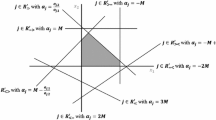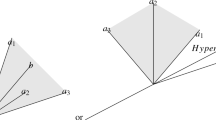Abstract
This and a companion paper consider how current implementations of the simplex method may be adapted to better solve linear programs that have a staged, or ‘staircase’, structure. The preceding paper considered ‘inversion’ routines that factorize the basis and solve linear systems. The present paper examines ‘pricing’ routines that compute reduced costs for nonbasic variables and that select a variable to enter the basis at each iteration. Both papers describe extensive (although preliminary) computer experiments, and can point to some quite promising results. For pricing in particular, staircase computation strategies appear to offer modest but consistent savings; staircase selection strategies, properly chosen, may offer substantial savings in number of iterations, time per iteration, or both.
Similar content being viewed by others
References
M. Benichou et al., “The efficient solution of large-scale linear programming problems—Some algorithmic techniques and computational results”,Mathematical Programming 13 (1977) 280–322.
H. Crowder and J.M. Hattingh, “Partially normalized pivot selection in linear programming”,Mathematical Programming Study 4 (1975) 12–25.
R. Fourer, “Sparse Gaussian elimination of staircase linear systems”, Technical Report SOL 79-17, Systems Optimization Laboratory, Department of Operations Research, Stanford University, Stanford, CA (1979).
R. Fourer, “Staircase matrices and systems”, Technical Report, Department of Industrial Engineering and Management Sciences, Northwestern University, Evanston, IL (1982).
R. Fourer, “Solving staircase linear programs by the simplex method. 1: Inversion,” Mathematical Programming 23 (1982) 274–313.
C.R. Glassey and P. Benenson, “A quadratic programming analysis of energy in the United States economy”, Report ES-116, Electric Power Research Institute, Palo Alto, CA (1975).
D. Goldfarb, “On the Bartels-Golub decomposition for linear programming bases”,Mathematical Programming 13 (1977) 272–279.
D. Goldfarb and J.K. Reid, “A practicable steepest-edge simplex algorithm”,Mathematical Programming 12 (1977) 361–371.
H.J. Greenberg and J.E. Kalan, “An exact update for Harris' TREAD”,Mathematical Programming Study 4 (1975) 26–29.
P.M.J. Harris, “Pivot selection methods of the Devex LP code”,Mathematical Programming 5 (1973) 1–28; reprinted inMathematical Programming Study 4 (1975) 30–57.
R.J. Herman, “Dynamically restricted pricing in the simplex method for linear programming”.Mathematical Programming 23 (1982) 314–325.
J.K. Ho, “Optimal design of multi-stage structures: a nested decomposition approach”,Computers and Structures 5 (1975) 249–255.
J.K. Ho, “Nested decomposition of a dynamic energy model”,Management Science 23 (1977) 1022–1026.
J.K. Ho, “A successive linear optimization approach to the dynamic traffic assignment problem”,Transportation Science 14 (1980) 295–305.
J.K. Ho and E. Loute, “A comparative study of two methods for staircase linear programs”,ACM Transactions on Mathematical Software 6 (1980) 17–30.
J.K. Ho and E. Loute, “A set of staircase linear programming test problems”,Mathematical Programming 20 (1981) 245–250.
“IBM OS fortran IV (H extended) compiler programmer's guide”, No. SC28-6852, International Business Machines Corporation (New York, 1974).
H. W. Kuhn and R.E. Quandt, “An experimental study of the simplex method”,Proceedings of Symposia in Applied Mathematics 15 (American Mathematical Society, 1963) 107–124.
A. S. Manne, “U.S. options for a transition from oil and gas to synthetic fuels”. Discussion Paper 26D, Public Policy Program, Kennedy School of Government, Harvard University. Cambridge, MA (1975).
D.K. Merchant and G.L. Nemhauser, “A model and an algorithm for the dynamic traffic assignment problems”,Transportation Science 12 (1978) 183–199.
“MPS III mathematical programming system: user manual” Ketron Inc., Arlington, VA (1975).
B. A. Murtagh and M. A. Saunders, “MINOS: a large-scale nonlinear programming system (for problems with linear constraints): user's guide”, Technical Report SOL 77-9, Systems Optimization Laboratory, Department of Operations Research, Stanford University, Stanford, CA (1977).
W. Orchard-Hays,Advanced linear-programming computing techniques (McGraw-Hill, New York, 1968).
J.K. Reid, “A sparsity-exploiting variant of the Bartels-Golub decomposition for linear programming bases”,Mathematical Programming 24 (1982) 55–69.
M.A. Saunders, “Large-scale linear programming using the Cholesky factorization”, Report STAN-CS-72-252, Computer Science Department, Stanford University, Stanford, CA (1972).
M.A. Saunders, “MINOS system manual”, Technical Report SOL 77-31, Systems Optimization Laboratory, Department of Operations Research, Stanford University, Stanford, CA (1977).
W. Swart, C. Smith and T. Holderby, “Expansion planning for a large dairy farm”, in: H.M. Salkin and J. Saha, eds.,Studies in linear programming (American Elsevier, New York, 1975) pp. 168–182.
J.A. Tomlin, “On pricing and backward transformation in linear programming”,Mathematical Programming 6 (1974) 42–47.
I. Vinson, “Triplex user's guide”, User Note 99, SLAC Computing Services, Stanford Linear Accelerator Center, Stanford, CA (1978).
P. Wolfe, “The composite simplex algorithm”,SIAM Review 7 (1965) 42–54.
P. Wolfe and L. Cutler, “Experiments in linear programming”, in: R.L. Graves and P. Wolfe, eds.,Recent advances in mathematical programming (McGraw-Hill, New York, 1963) pp. 177–200.
Author information
Authors and Affiliations
Rights and permissions
About this article
Cite this article
Fourer, R. Solving staircase linear programs by the simplex method, 2: Pricing. Mathematical Programming 25, 251–292 (1983). https://doi.org/10.1007/BF02594780
Received:
Revised:
Issue Date:
DOI: https://doi.org/10.1007/BF02594780




